Remote Sensing and Historical Morphodynamics of Alluvial Plains. The 1909 Indus Flood and the City of Dera Ghazi Khan (Province of Punjab, Pakistan)
Abstract
:1. Introduction
2. Study Case: Dera Ghazi Khan and the River Indus
3. Materials and Methods
3.1. Historical Sources
3.2. Historical Map Analysis
3.3. RS Approach
3.3.1. Declassified Data and Satellite Historical Photographs
3.3.2. Multispectral Satellite Imagery
3.3.3. Microtopographic Data
4. Results
4.1. Historical Landscape Reconstruction
4.2. Remote Sensing Analyses
4.2.1. Dera Ghazi Khan Old Town
4.2.2. River Channels
5. Discussion and Conclusions
5.1. Integrating Remote Sensing and Recent Historical Data in the Study of Human Settlement and Riverine Dynamics
5.1.1. DG Khan Old Town
5.1.2. River Channels
5.1.3. The Value of Historical Sources and Cartographic Material in RS Approaches
5.2. River Morphodynamics, Settlement Patterns and Archaeological Record in a Long-Term Perspective
5.3. Historical Social Responses to River Morphodynamics
Supplementary Materials
Author Contributions
Funding
Acknowledgments
Conflicts of Interest
References
- Meadows, A.; Meadows, P. (Eds.) The Indus River: Biodiversity, Resources, Humankind; OUP Pakistan: Karachi, Pakistan, 1999; ISBN 978-0-19-577905-9. [Google Scholar]
- Dong, S.; Bandyopadhyay, J.; Chaturvedi, S. Environmental Sustainability from the Himalayas to the Oceans: Struggles and Innovations in China and India; Springer: Cham, Switzerland, 2017. [Google Scholar]
- Agnihotri, I. Ecology, land use and colonisation: The canal colonies of Punjab. Indian Econ. Soc. Hist. Rev. 1996, 33, 37–58. [Google Scholar] [CrossRef]
- Hill, C.V. River of Sorrow: Environment and Social Control in Riparian North India, 1770–1994/Christopher V. Hill; Association for Asian Studies: Ann Arbor, MI, USA, 1997. [Google Scholar]
- Schuldenrein, J.; Wright, R.P.; Mughal, M.R.; Khan, M.A. Landscapes, soils, and mound histories of the Upper Indus Valley, Pakistan: New insights on the Holocene environments near ancient Harappa. J. Archaeol. Sci. 2004, 31, 777–797. [Google Scholar] [CrossRef]
- Jansen, M.; Mulloy, M.; Urban, G. Forgotten Cities on the Indus: Early Civilization in Pakistan from the 8th to the 2nd Millennium BC; Verlag Philipp von Zabern: Mainz, Germany, 1991. [Google Scholar]
- Mughal, M.R. A Preliminary Review of Archaeological Surveys in Punjab and Sindh: 1993–95. South Asian Stud. 1997, 13, 241–249. [Google Scholar] [CrossRef]
- Crawford, O.G.S. A Century of Air-photography. Antiquity 1954, 28, 206–210. [Google Scholar] [CrossRef]
- Orengo, H.A.; Knappett, C. Toward a Definition of Minoan Agro-Pastoral Landscapes: Results of the Survey at Palaikastro (Crete). Am. J. Archaeol. 2018, 122, 479. [Google Scholar] [CrossRef]
- Menze, B.H.; Ur, J.A.; Sherratt, A.G. Detection of Ancient Settlement Mounds: Archaeological Survey Based on the SRTM Terrain Model. Photogramm. Eng. Remote Sens. 2006, 72, 321–327. [Google Scholar] [CrossRef]
- Chase, A.F.; Chase, D.Z.; Weishampel, J.F.; Drake, J.B.; Shrestha, R.L.; Slatton, K.C.; Awe, J.J.; Carter, W.E. Airborne LiDAR, archaeology, and the ancient Maya landscape at Caracol, Belize. J. Archaeol. Sci. 2011, 38, 387–398. [Google Scholar] [CrossRef]
- Evans, D.H.; Fletcher, R.J.; Pottier, C.; Chevance, J.-B.; Soutif, D.; Tan, B.S.; Im, S.; Ea, D.; Tin, T.; Kim, S.; et al. Uncovering archaeological landscapes at Angkor using lidar. Proc. Natl. Acad. Sci. USA 2013, 110, 12595–12600. [Google Scholar] [CrossRef] [Green Version]
- Pournelle, J.R. Marshland of Cities: Deltaic Landscapes and the Evolution of Early Mesopotamian Civilization; University of California: San Diego, CA, USA, 2003. [Google Scholar]
- Hritz, C. Tracing Settlement Patterns and Channel Systems in Southern Mesopotamia Using Remote Sensing. J. Field Archaeol. 2010, 35, 184–203. [Google Scholar] [CrossRef]
- Orengo, H.A.; Krahtopoulou, A.; Garcia-Molsosa, A.; Palaiochoritis, K.; Stamati, A. Photogrammetric re-discovery of the hidden long-term landscapes of western Thessaly, central Greece. J. Archaeol. Sci. 2015, 64, 100–109. [Google Scholar] [CrossRef]
- Yashpal, S.B.; Sood, R.K.; Agarwal, D.P. Remote sensing of the lost Saraswati river. Proce. Indian Acad. Sci. (Earth Planet. Sci.) 1980, 89, 317–337. [Google Scholar]
- Ramasamy, S.M.; Bakliwal, P.C.; Verma, R.P. Remote sensing and river migration in Western India. Int. J. Remote Sens. 1991, 12, 2597–2609. [Google Scholar] [CrossRef]
- Gupta, A.K.; Sharma, J.R.; Sreenivasan, G. Using satellite imagery to reveal the course of an extinct river below the Thar Desert in the Indo-Pak region. Int. J. Remote Sens. 2011, 32, 5197–5216. [Google Scholar] [CrossRef]
- Rajani, M.B.; Rajawat, A.S. Potential of satellite based sensors for studying distribution of archaeological sites along palaeo channels: Harappan sites a case study. J. Archaeol. Sci. 2011, 38, 2010–2016. [Google Scholar] [CrossRef]
- Dave, A.K.; Courty, M.-A.; Fitzsimmons, K.E.; Singhvi, A.K. Revisiting the contemporaneity of a mighty river and the Harappans: Archaeological, stratigraphic and chronometric constraints. Quat. Geochronol. 2019, 49, 230–235. [Google Scholar] [CrossRef]
- Balbo, A.L.; Rondelli, B.; Cecília Conesa, F.; Lancelotti, C.; Madella, M.; Ajithprasad, P. Contributions of geoarchaeology and remote sensing to the study of Holocene hunter–gatherer and agro-pastoral groups in arid margins: The case of North Gujarat (Northwest India). Quat. Int. 2013, 308–309, 53–65. [Google Scholar] [CrossRef]
- Conesa, F.C.; Madella, M.; Galiatsatos, N.; Balbo, A.L.; Rajesh, S.V.; Ajithprasad, P. CORONA Photographs in Monsoonal Semi-arid Environments: Addressing Archaeological Surveys and Historic Landscape Dynamics over North Gujarat, India. Archaeol. Prospect. 2015, 22, 75–90. [Google Scholar] [CrossRef]
- Giosan, L.; Clift, P.D.; Macklin, M.G.; Fuller, D.Q.; Constantinescu, S.; Durcan, J.A.; Stevens, T.; Duller, G.A.T.; Tabrez, A.R.; Gangal, K.; et al. Fluvial landscapes of the Harappan civilization. Proc. Natl. Acad. Sci. USA 2012, 109, E1688–E1694. [Google Scholar] [CrossRef]
- Wright, R.; Hritz, C. Satellite Remote Sensing Imagery: New Evidence for Sites and Ecologies in the Upper Indus. In South Asian Archaeology 2007; BAR International Series: Oxford, UK, 2013; pp. 315–321. [Google Scholar]
- Orengo, H.A.; Petrie, C.A. Large-Scale, Multi-Temporal Remote Sensing of Palaeo-River Networks: A Case Study from Northwest India and its Implications for the Indus Civilisation. Remote Sens. 2017, 9, 735. [Google Scholar] [CrossRef]
- Orengo, H.A.; Petrie, C.A. Multi-scale relief model (MSRM): A new algorithm for the visualization of subtle topographic change of variable size in digital elevation models. Earth Surf. Process. Landf. 2018, 43, 1361–1369. [Google Scholar] [CrossRef]
- Singh, R.N.; Green, A.S.; Ranjan, L.M.; Alam, A.; Petrie, C.A. Between the Hinterlands: Preliminary Results from the TwoRains Survey in Northwest India 2017. Man Environ. 2018, in press. [Google Scholar]
- Petrie, C.A.; Orengo, H.A.; Green, A.S.; Walker, J.S.; Garcia, A.; Conesa, F.C.; Singh, R.N.; Knox, J.R. Mapping archaeology by mapping an empire: Using historical maps to reconstruct ancient settlement landscapes in modern India & Pakistan. Geosciences 2018, in press. [Google Scholar]
- Singh, M. The British Indian Empire: Military Geography and Emergence of New Military Landscapes in Punjab. Shabd–Braham Int. Res. J. Indian Lang. 2017, 5, 32–35. [Google Scholar]
- Akhtar, S. The Historical and Archeological Significance Dera Ghazi Khan District through Ages. Archaeol. Anthropol. Open Access 2018, 2, 4. [Google Scholar] [CrossRef]
- Akhtar, A. Indus Basin Floods: Mechanisms, Impacts, and Management; Asian Development Bank: Mandaluyong City, Philippines, 2013; p. 67. [Google Scholar]
- Webster, P.J.; Toma, V.E.; Kim, H.-M. Were the 2010 Pakistan floods predictable? Geophys. Res. Lett. 2011, 38. [Google Scholar] [CrossRef] [Green Version]
- Gaurav, K.; Sinha, R.; Panda, P.K. The Indus flood of 2010 in Pakistan: A perspective analysis using remote sensing data. Nat. Hazards 2011, 59, 1815. [Google Scholar] [CrossRef]
- Hashmi, H.N.; Siddiqui, Q.T.M.; Ghumman, A.R.; Kamal, M.A. A critical analysis of 2010 floods in Pakistan. Afr. J. Agric. Res. 2012, 7, 1054–1067. [Google Scholar]
- Kirsch, T.D.; Wadhwani, C.; Sauer, L.; Doocy, S.; Catlett, C. Impact of the 2010 Pakistan Floods on Rural and Urban Populations at Six Months. PLoS Curr. 2012, 4. [Google Scholar] [CrossRef]
- Tariq, M.A.U.R.; van de Giesen, N. Floods and flood management in Pakistan. Phys. Chem. Earth Parts A/B/C 2012, 47–48, 11–20. [Google Scholar] [CrossRef]
- Daily Images of the 2010 Flood Episodes Are Available in NASA Worldview Web Service. Available online: https://worldview.earthdata.nasa.gov/?p=geographic&l=MODIS_Terra_CorrectedReflectance_TrueColor,Graticule(hidden),Reference_Labels(hidden),Coastlines(hidden)&t=2018-11-14-T00%3A00%3A00Z&z=3&v=51.000945871291805,5.956715959569404,110.8720396212918,39.14421595956941 (accessed on 14 November 2018).
- See, e.g., The Cartographic Material about Pakistan Collected by the UN Program UNOSAT. Available online: http://www.unitar.org/unosat/maps/PAK (accessed on 14 November 2018).
- Heavy Rains and Dry Lands Don’t Mix: Reflections on the 2010 Pakistan Flood. Available online: https://earthobservatory.nasa.gov/Features/PakistanFloods (accessed on 14 November 2018).
- Amarnath, G.; Rajah, A. An evaluation of flood inundation mapping from MODIS and ALOS satellites for Pakistan. Geomat. Nat. Hazards Risk 2016, 7, 1526–1537. [Google Scholar] [CrossRef]
- Scholberg, H. The District Gazetteers of British India. A Bibliography; Bibliotheca Asiatica; [Poststr. 4]; Inter Documentation: Zug, Switzerland, 1970; Volume 3. [Google Scholar]
- Gazetter of the Dera Ghazi Khan District, 1893–1897; Reprint; Sang-e-Meel Publications: Lahore, Pakistan, 1990.
- Weil, B. The Rivers Come: Colonial Flood Control and Knowledge Systems in the Indus Basin, 1840s–1930s. Environ. History 2006, 12, 3–29. [Google Scholar] [CrossRef]
- Times of India. The Passing of Dera Ghazi Khan; Times of India: Bombay, India, 1910. [Google Scholar]
- Bellasis, E.S. Punjab Rivers and Works; E. & F.N. Spon, Ltd.: London, UK, 1912. [Google Scholar]
- Declassified Satellite Imagery—1 | The Long Term Archive. Available online: https://lta.cr.usgs.gov/declass_1 (accessed on 14 November 2018).
- Casana, J.; Cothren, J. Stereo analysis, DEM extraction and orthorectification of CORONA satellite imagery: Archaeological applications from the Near East. Antiquity 2008, 82, 732–749. [Google Scholar] [CrossRef]
- Scollar, I.; Galiatsatos, N.; Mugnier, C. Mapping from CORONA: Geometric Distortion in KH4 Images. Photogramm. Eng. Remote Sens. 2016, 82, 7–13. [Google Scholar] [CrossRef]
- Masson, C. Narrative of Various Journeys in Balochistan, Afghanistan, and the Panjab: Including a Residence in Those Countries from 1826 to 1838/Charles Masson; Richard Bentley: London, UK, 1842. [Google Scholar]
- Global Surface Water Explorer. Available online: https://global-surface-water.appspot.com/ (accessed on 15 November 2018).
- Pekel, J.-F.; Cottam, A.; Gorelick, N.; Belward, A.S. High-resolution mapping of global surface water and its long-term changes. Nature 2016, 540, 418–422. [Google Scholar] [CrossRef] [PubMed]
- Green, A.S.; Singh, R.N.; Alam, A.; Garcia, A.; Greene, L.M.; Conesa, F.C.; Orengo, H.A.; Ranjan, A.; Petrie, C.A. Re-discovering dynamic ancient landscapes: Archaeological survey of features from historical maps in northwest India and their implications for the large-scale distribution of settlements throughout South Asia. Remote Sens. 2018. in preparation. [Google Scholar]
- Possehl, G.L. Indus Age: The Beginnings; Oxford & IBH Publihing Co.: New Delhi, India, 1999; ISBN 81-204-1296-6. [Google Scholar]
- Centre, U.W.H. Archaeological Ruins at Moenjodaro. Available online: https://whc.unesco.org/en/list/138/ (accessed on 14 November 2018).
- Miller, H.M.-L. Surplus in the indus Civilization. In Surplus: The Politics of Production and the Strategies of Everyday Life; University Press of Colorado: Boulder, CO, USA, 2015; pp. 97–120. [Google Scholar]
- Munir, B.A.; Iqbal, J. Flash flood water management practices in Dera Ghazi Khan City (Pakistan): A remote sensing and GIS prospective. Nat. Hazards 2016, 81, 1303–1321. [Google Scholar] [CrossRef]
- Wright, R.P. The Ancient Indus: Urbanism, Economy, and Society, Case Studies in Early Societies; Cambridge University Press: Cambridge, UK, 2010. [Google Scholar]
- Miller, H.M.-L. Water supply, labor requirements, and land ownership in Indus floodplain agricultural systems. In Agricultural Strategies; The Cotsen Institute of Archaeology Press: Los Angeles, CA, USA, 2006; pp. 92–128. [Google Scholar]
- Jansen, M. Water supply and sewage disposal at Mohenjo-Daro. World Archaeol. 1989, 21, 177–192. [Google Scholar] [CrossRef]
- Petrie, C.A.; Singh, R.N.; Bates, J.; Dixit, Y.; French, C.A.I.; Hodell, D.A.; Jones, P.J.; Lancelotti, C.; Lynam, F.; Neogi, S.; et al. Adaptation to Variable Environments, Resilience to Climate Change: Investigating Land, Water and Settlement in Indus Northwest India. Curr. Anthropol. 2017, 58, 1–30. [Google Scholar] [CrossRef]
- Elphinstone, M. An Account of the Kingdom of Caubul, and Its Dependencies, in Persia, Tartary, and India (1842); Richard Bentley: London, UK, 1842. [Google Scholar]
- Conesa, F.C.; Devanthéry, N.; Balbo, A.L.; Madella, M.; Monserrat, O. Use of Satellite SAR for Understanding Long-Term Human Occupation Dynamics in the Monsoonal Semi-Arid Plains of North Gujarat, India. Remote Sens. 2014, 6, 11420–11443. [Google Scholar] [CrossRef] [Green Version]
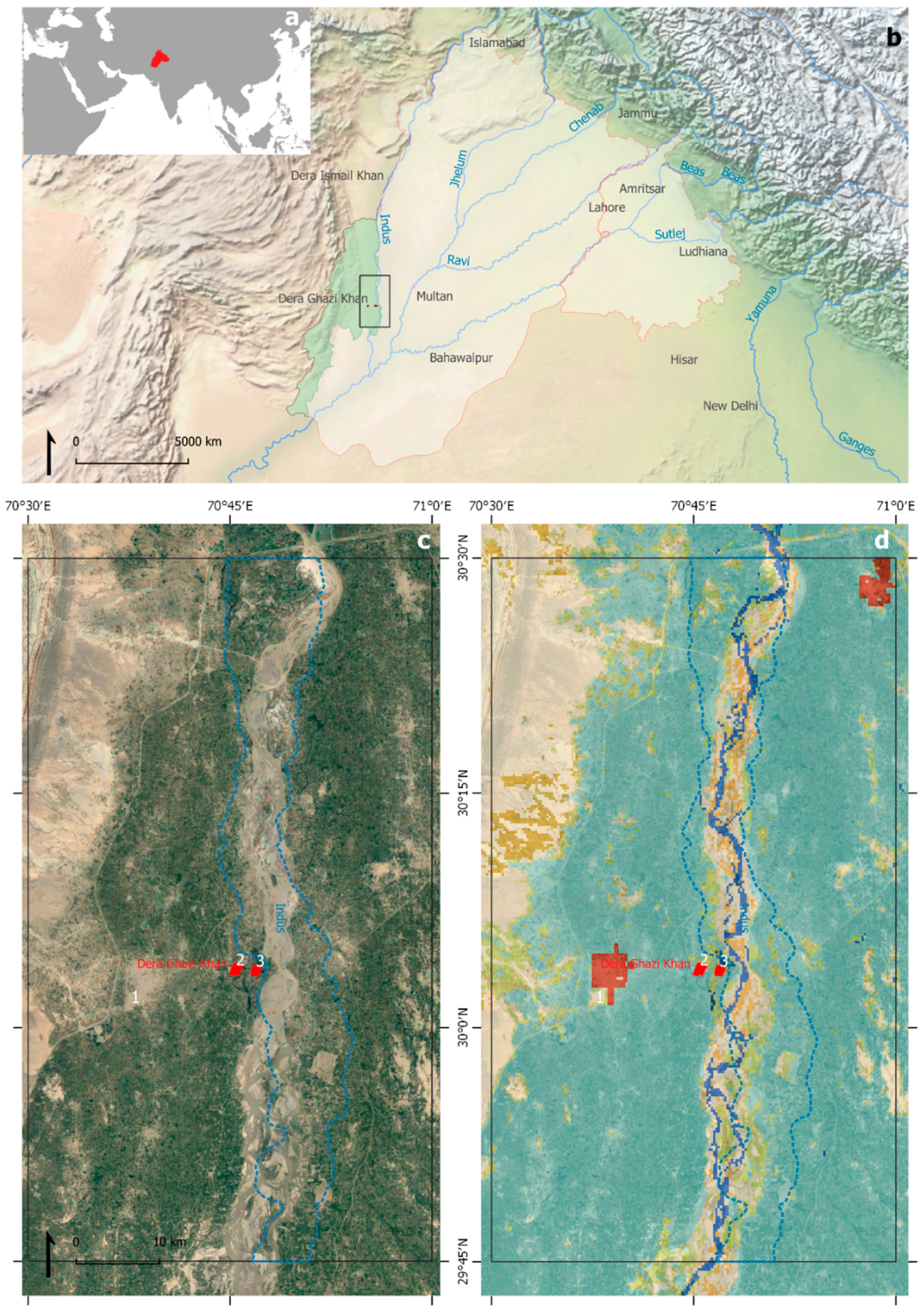
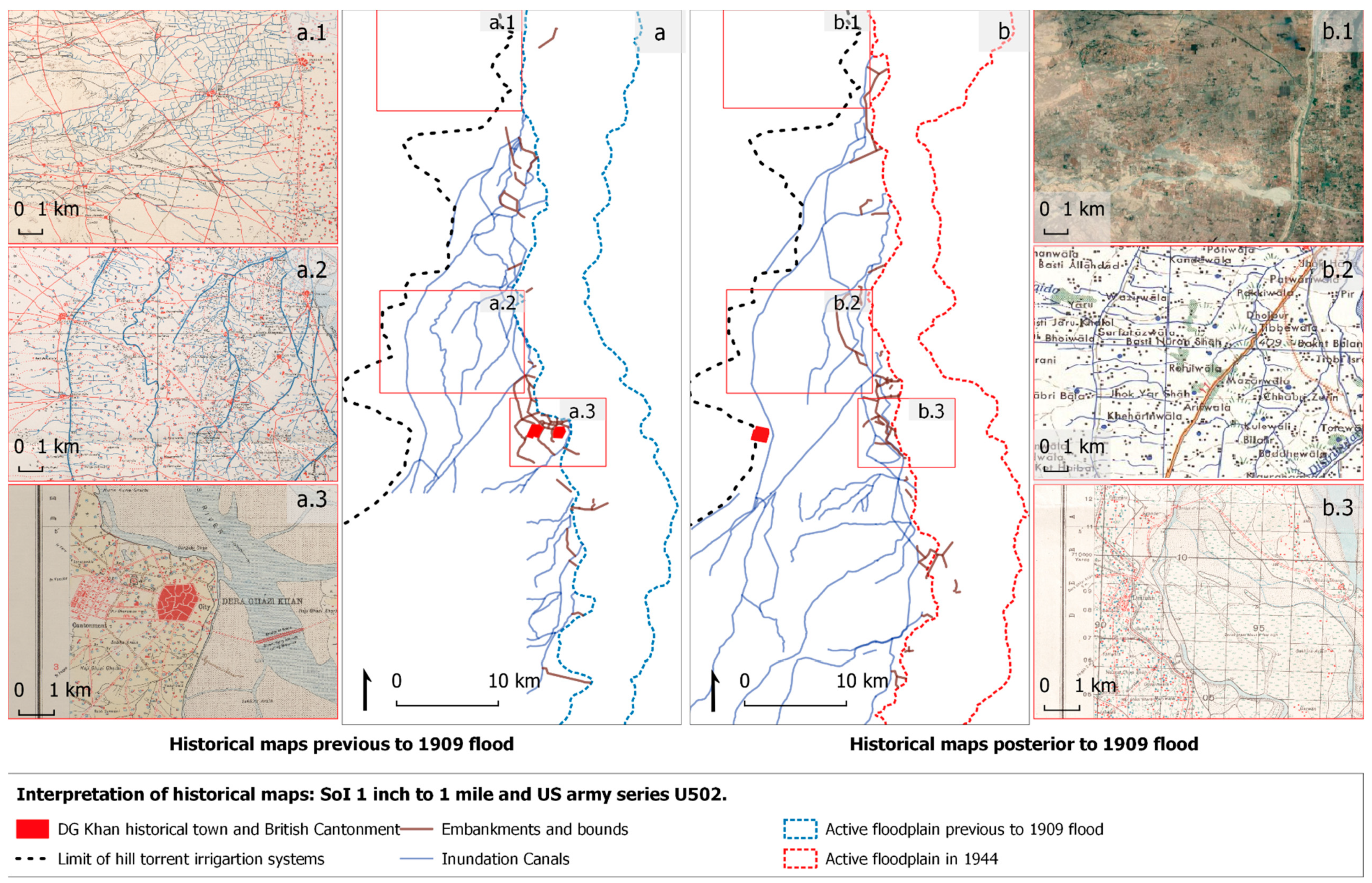
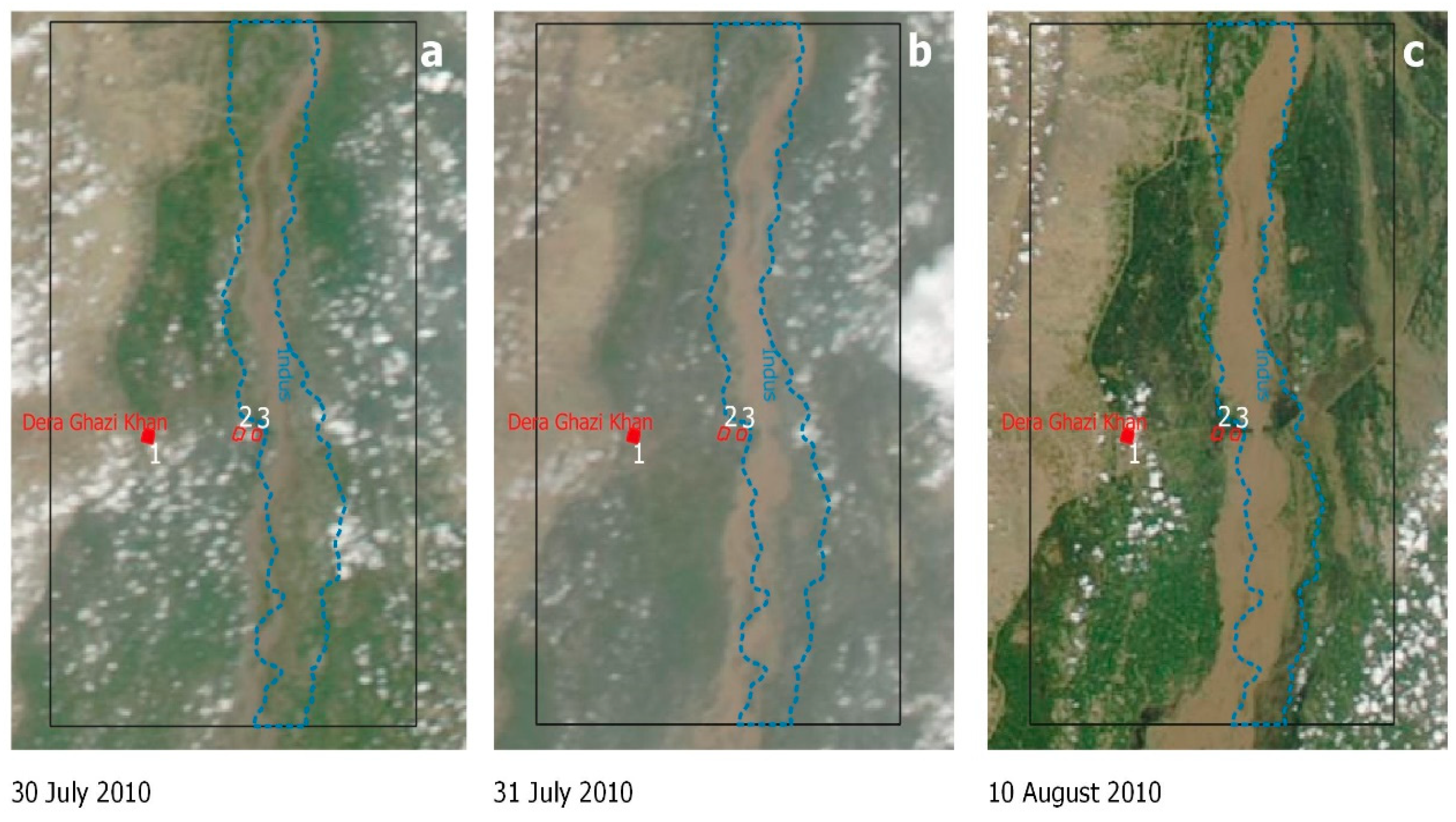
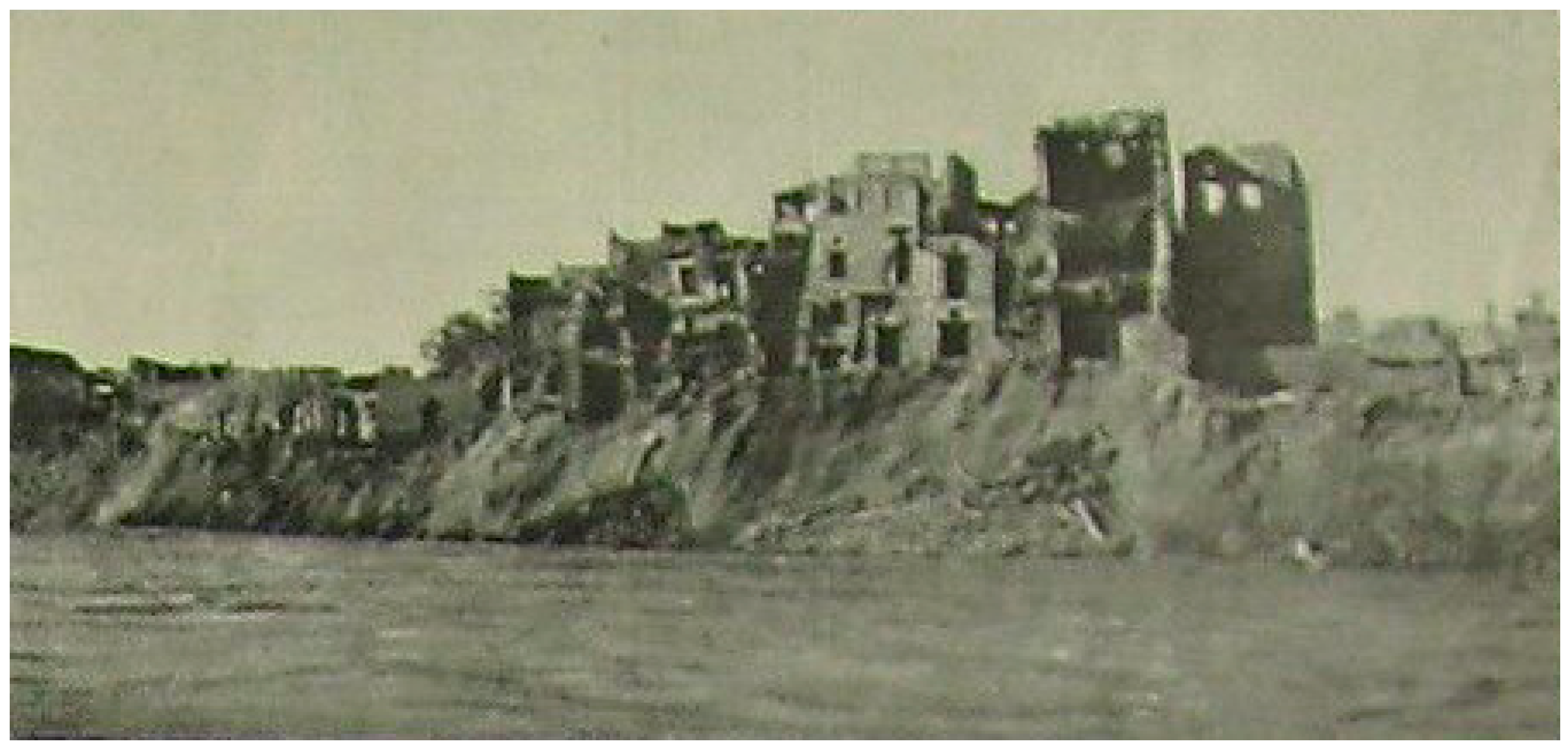
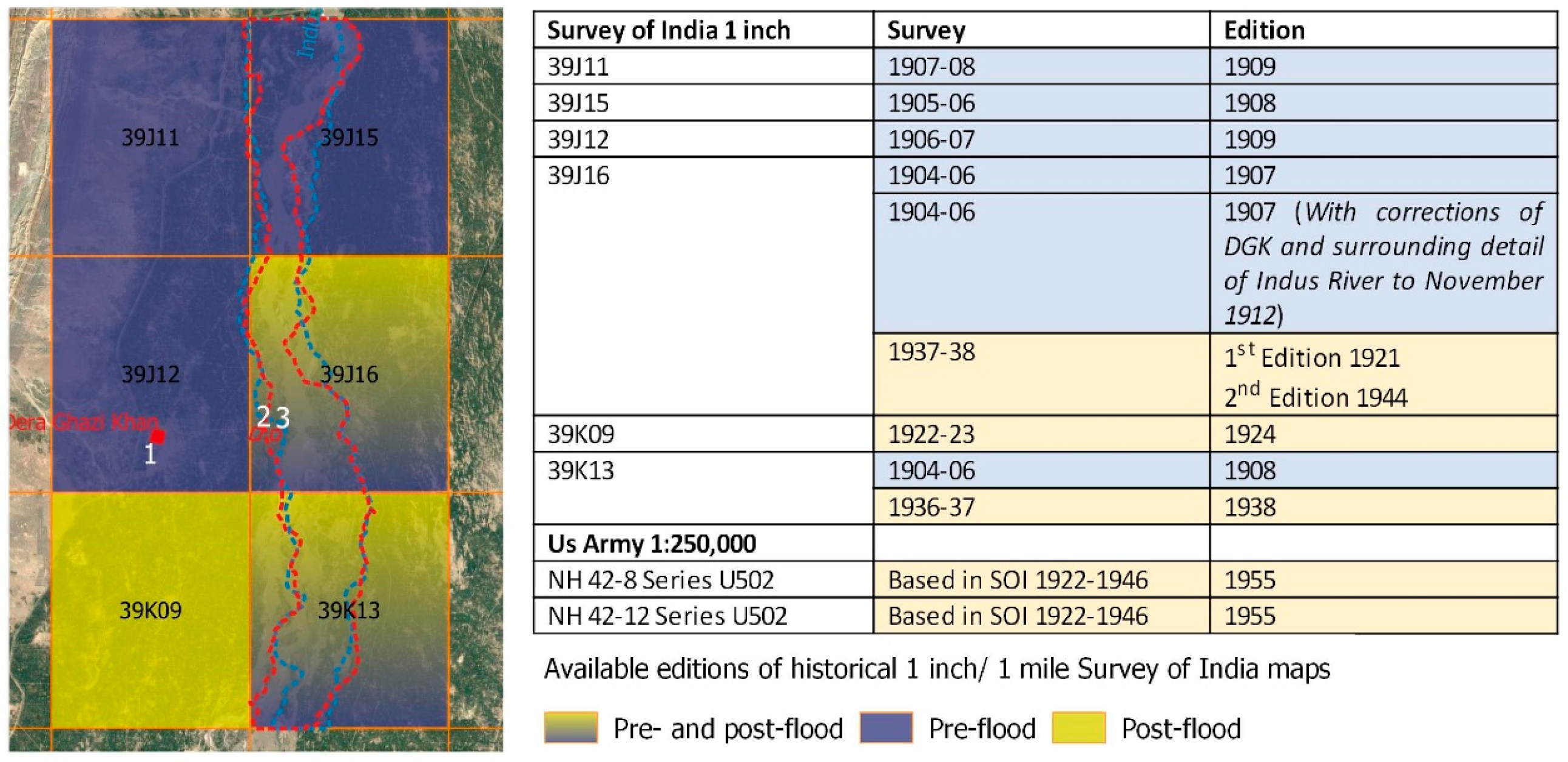
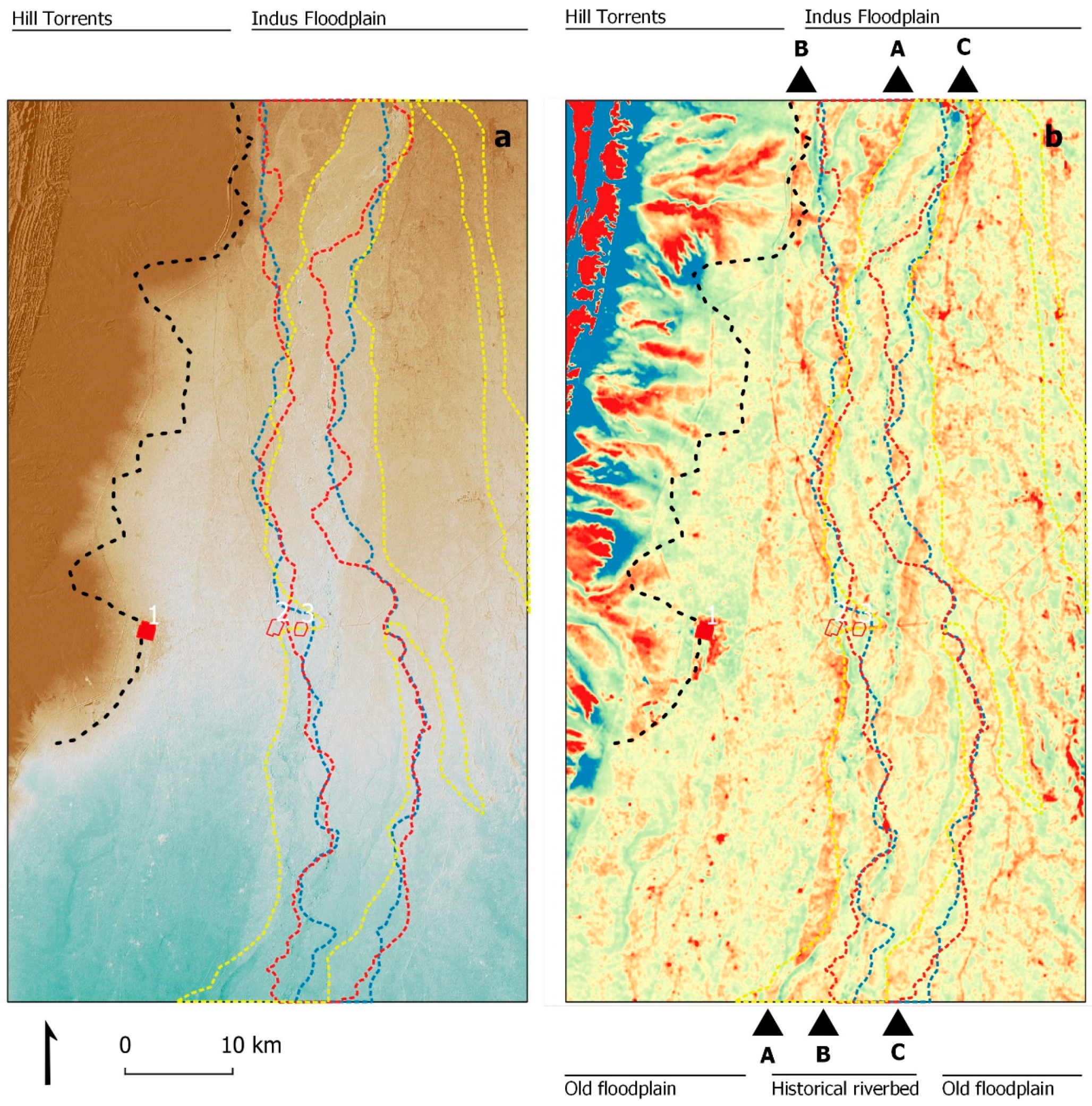
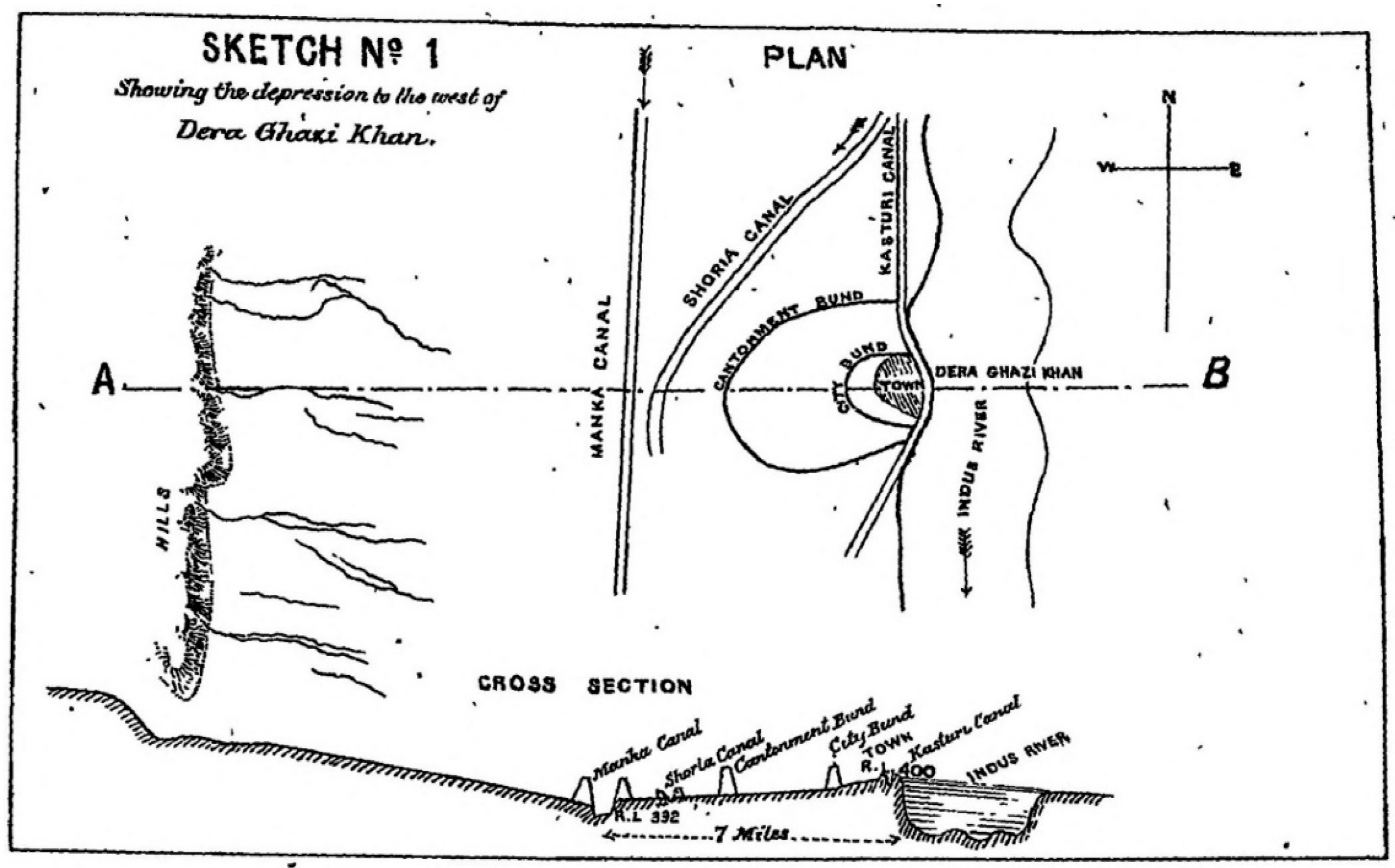
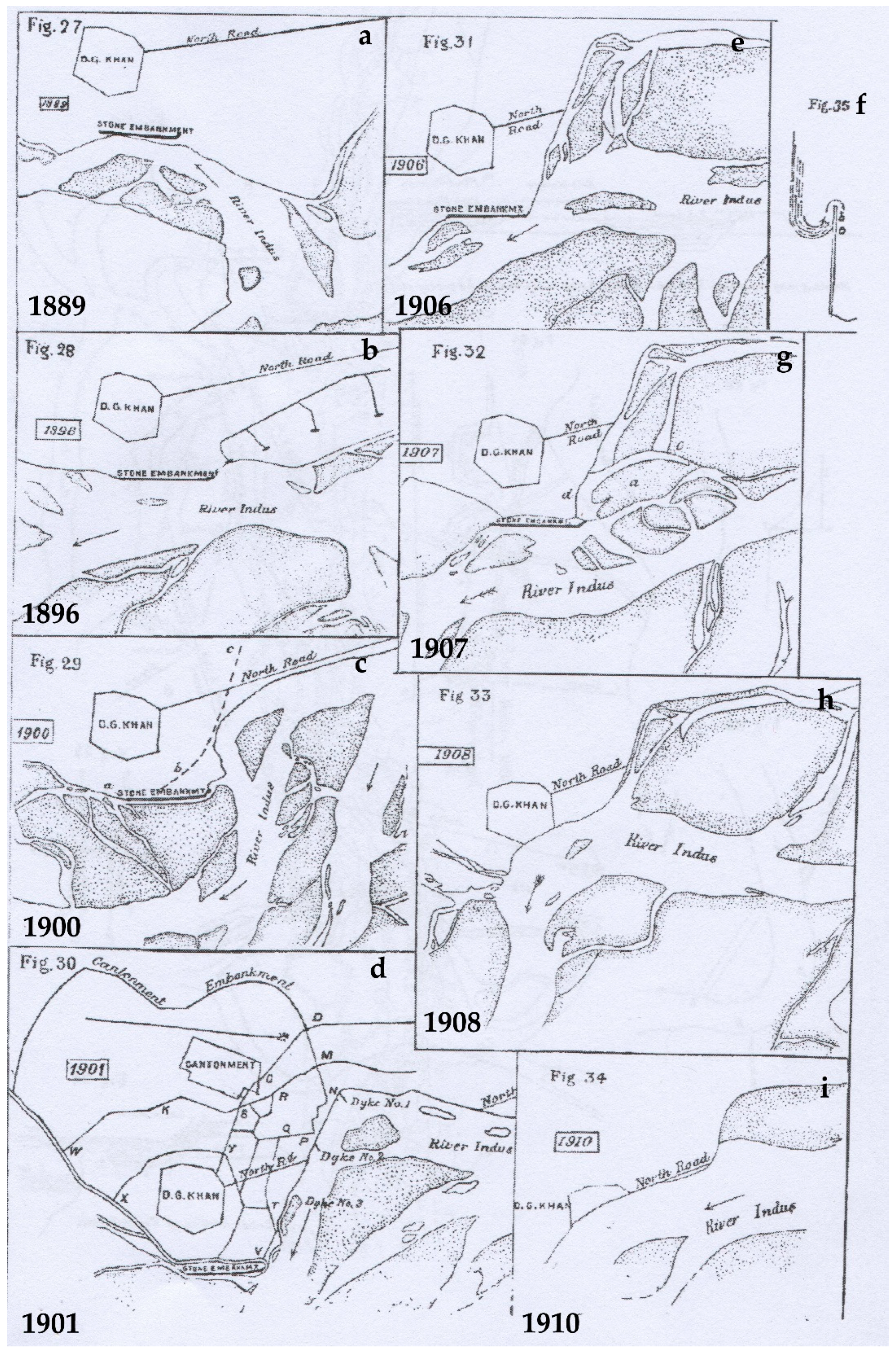
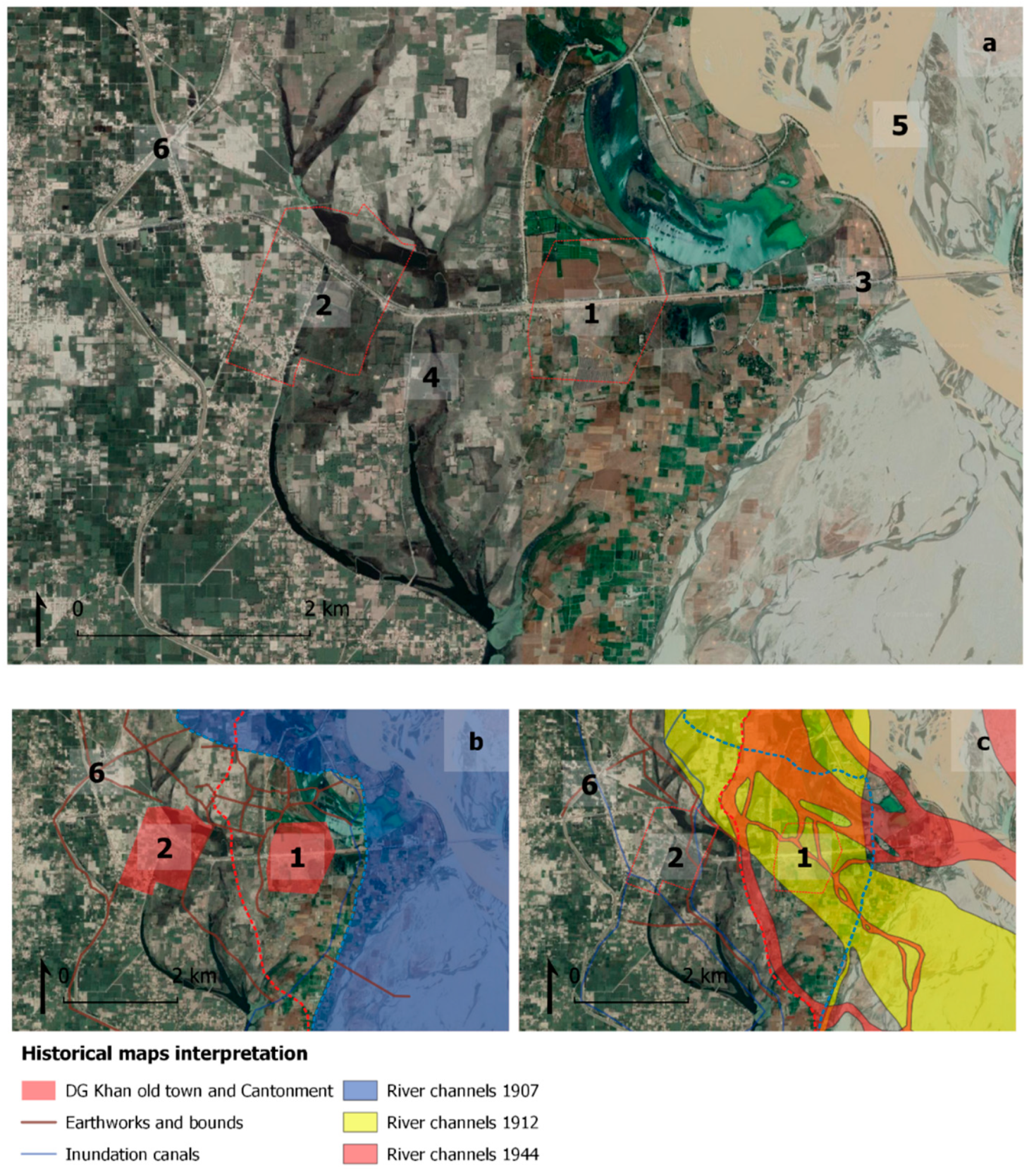
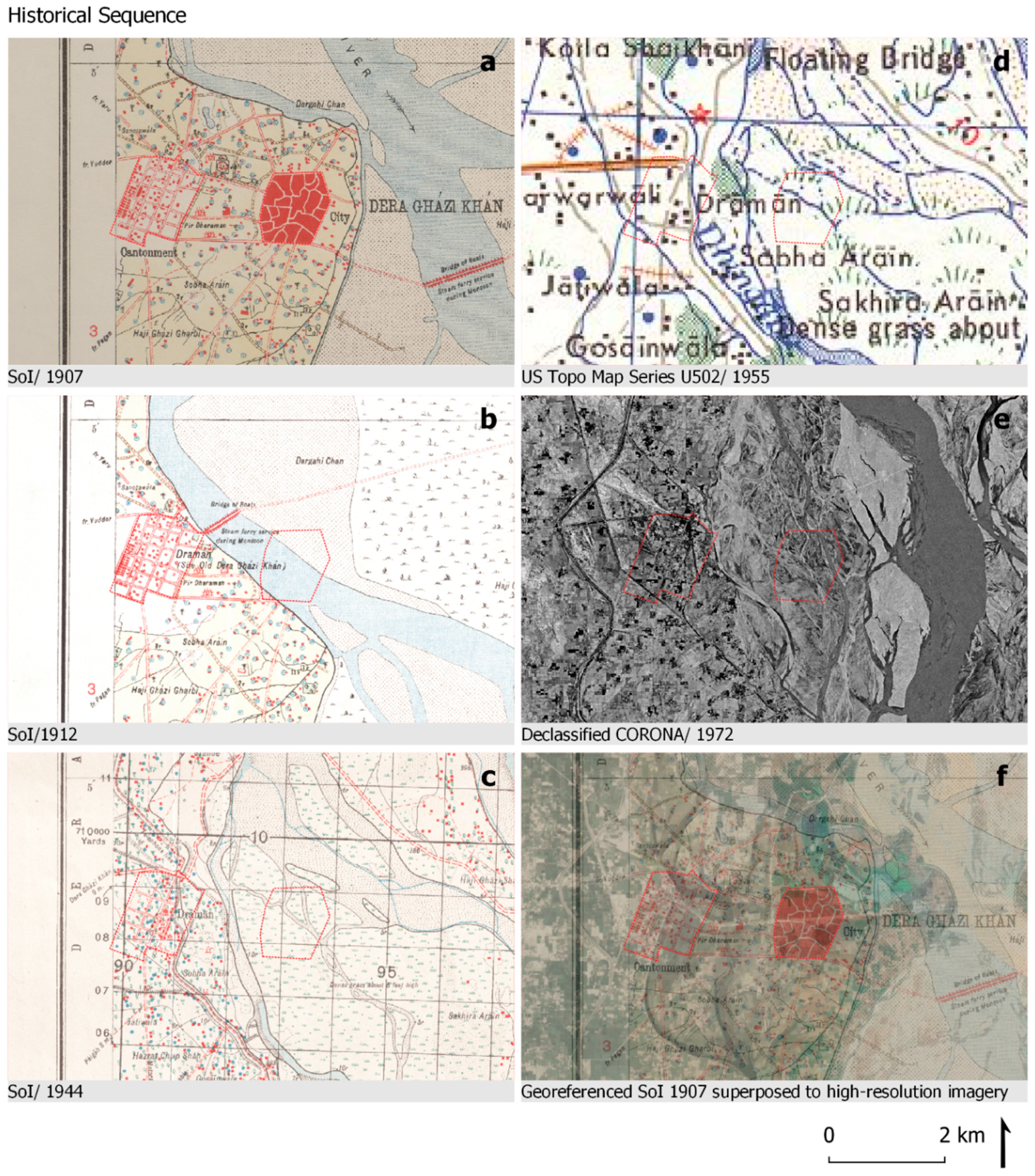
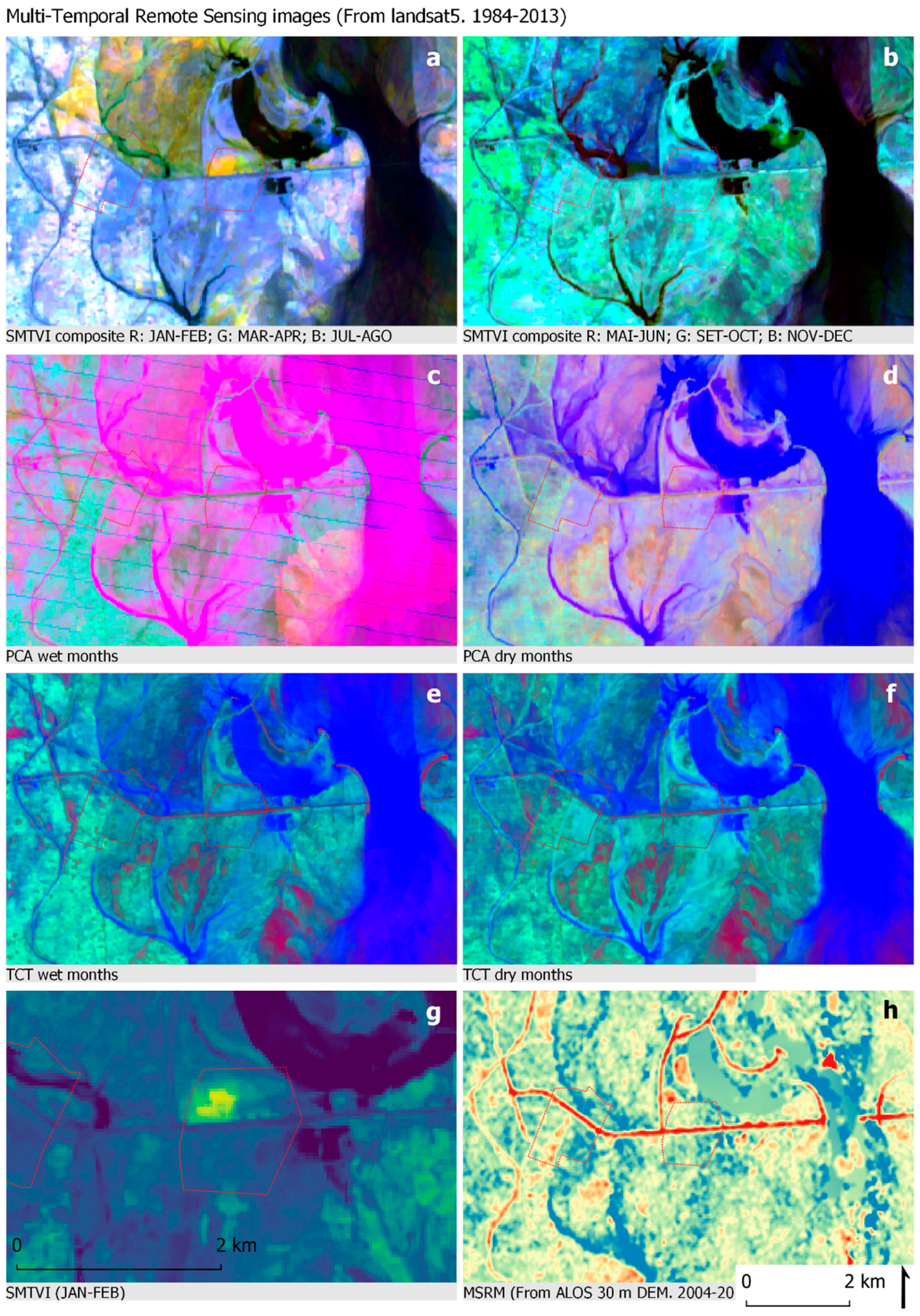
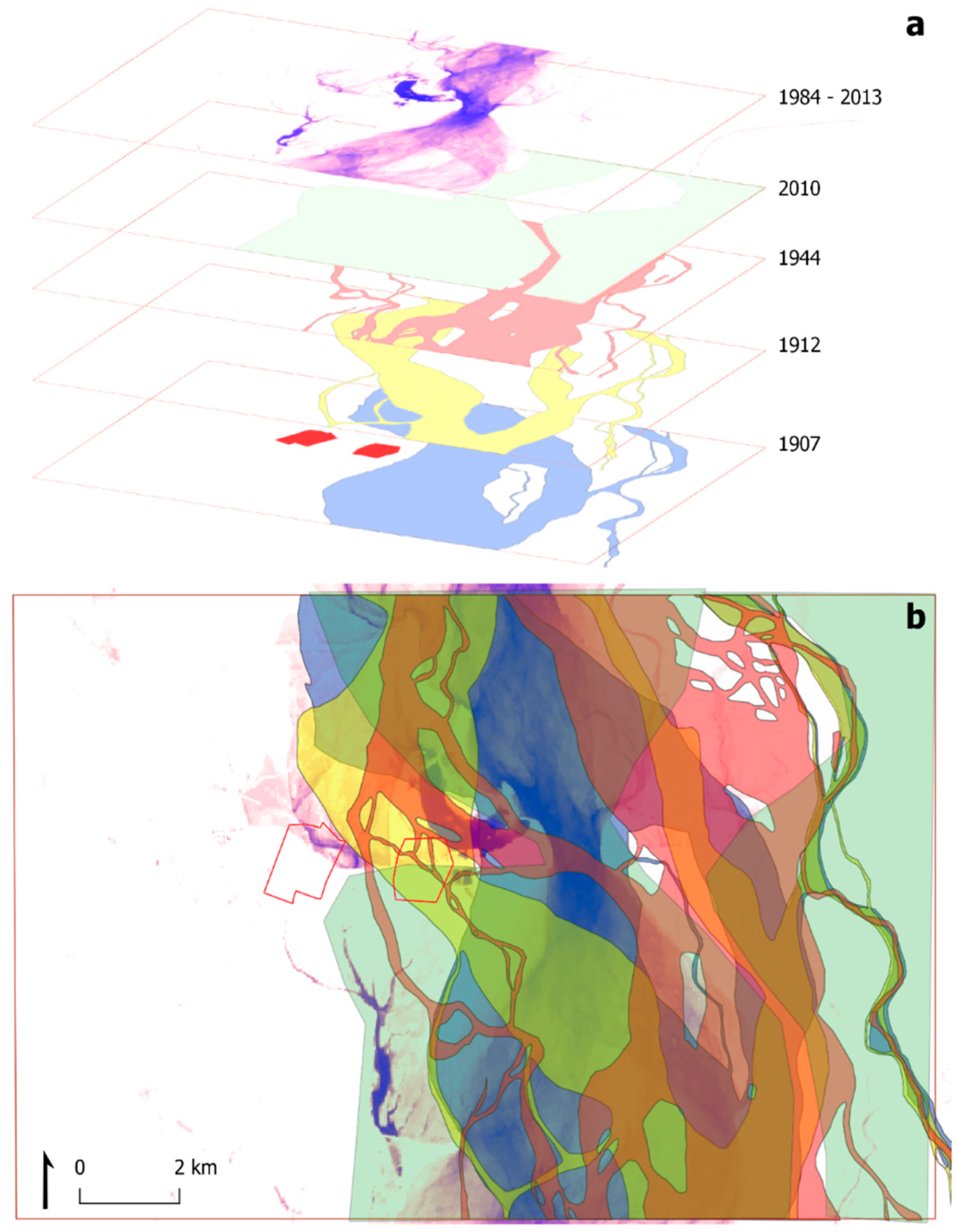
| Date | River Dynamics | Other Historical Data |
|---|---|---|
| Mid. 15th C. AD | Foundation of DG Khan | |
| 1787 | Abrupt change in the river | |
| 1812 | Flood | |
| 1833 | Flood | |
| 1841 | Flood | |
| 1842 | Sihk Wars. British take control of DG Khan. | |
| 1858 | Flood swept away cantonment | |
| 1857 | Embankment build | |
| 1870’s | Original reports compiled in the 1893–1897 Gazetteer. | |
| 1878 | Embankment overtop damage cantonment | |
| 1882 | Embankment breached out puts town and cantonment in risk | |
| 1888–1889 | High floods | |
| 1889–91 | Building of stone embarkments | |
| 1895 | Breach of the stone embankment | |
| 1895–97 | Embankment extension Still risk | |
| 1897 | Reported problems in buildings and health due high levels of underground water | Compilation of the district Gazetteer |
| 1899 | New works increases municipality debt | |
| 1900 | Embankment damaged when river cuts its Western banks | |
| 1901 | Decision to undertake new works. | |
| 1902 | Works interrupted by an early flood | |
| 1904–1906 | Surveys for the elaboration of SoI 1” to 1-mile maps | |
| 1906 | River cut its Western bank | |
| 1907 | Edition of the SoI 1” to 1-mile map | |
| 1908 | Stone embankment collapse | |
| 1909 | The Indus enters the old town | |
| 1910 | River eroding the remains of the city. City in process of abandonment | Article in The Times of India Illustrated Weekly Supplement |
| 1910/1911 | Decision to move the city in its new location | |
| 1912 | Publishing of the second edition of “Punjab Rivers and Works” |
© 2018 by the authors. Licensee MDPI, Basel, Switzerland. This article is an open access article distributed under the terms and conditions of the Creative Commons Attribution (CC BY) license (http://creativecommons.org/licenses/by/4.0/).
Share and Cite
Garcia, A.; Orengo, H.A.; Conesa, F.C.; Green, A.S.; Petrie, C.A. Remote Sensing and Historical Morphodynamics of Alluvial Plains. The 1909 Indus Flood and the City of Dera Ghazi Khan (Province of Punjab, Pakistan). Geosciences 2019, 9, 21. https://doi.org/10.3390/geosciences9010021
Garcia A, Orengo HA, Conesa FC, Green AS, Petrie CA. Remote Sensing and Historical Morphodynamics of Alluvial Plains. The 1909 Indus Flood and the City of Dera Ghazi Khan (Province of Punjab, Pakistan). Geosciences. 2019; 9(1):21. https://doi.org/10.3390/geosciences9010021
Chicago/Turabian StyleGarcia, Arnau, Hector A. Orengo, Francesc C. Conesa, Adam S. Green, and Cameron A. Petrie. 2019. "Remote Sensing and Historical Morphodynamics of Alluvial Plains. The 1909 Indus Flood and the City of Dera Ghazi Khan (Province of Punjab, Pakistan)" Geosciences 9, no. 1: 21. https://doi.org/10.3390/geosciences9010021
APA StyleGarcia, A., Orengo, H. A., Conesa, F. C., Green, A. S., & Petrie, C. A. (2019). Remote Sensing and Historical Morphodynamics of Alluvial Plains. The 1909 Indus Flood and the City of Dera Ghazi Khan (Province of Punjab, Pakistan). Geosciences, 9(1), 21. https://doi.org/10.3390/geosciences9010021






